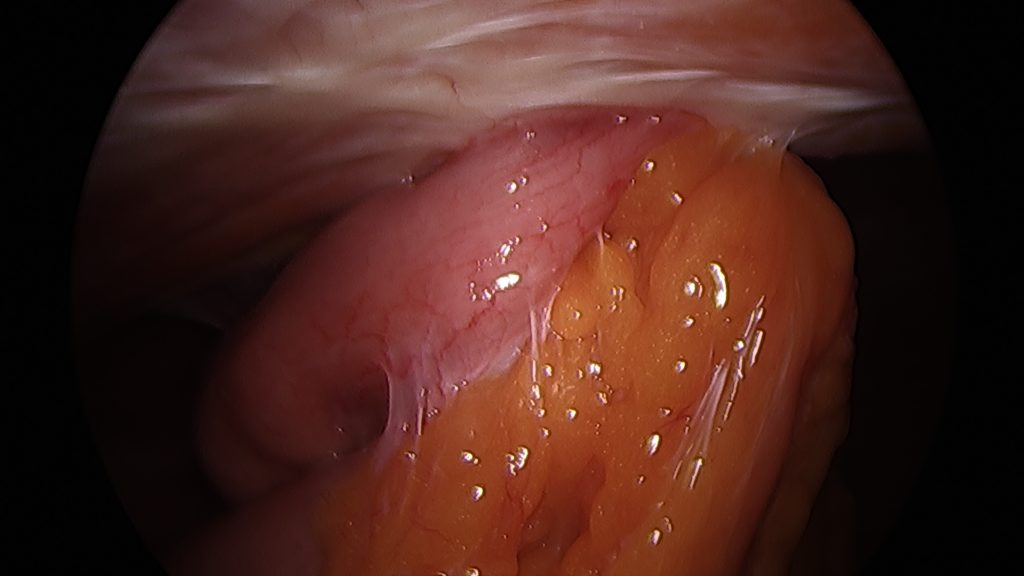ABDOMINAL ADHESIONS -PAIN AND OBSTRUCTION
Adhesions represent an essential part of the healing process in the abdomen. We heal injuries by growing new tissues and generating scar tissue both in the skin where we can see and in the abdomen where we cannot.
When structures in our abdomen are injured either by intentional surgery, trauma, or infections our bodies react by creating scar tissue. Inside the abdomen these scars can often create abnormal bonds or “adhesions” between structures that are not meant to be joined. These adhesions are typically trivia and asymptomatic but problems do occur and people can develop pain and even bowel obstructions as a consequence.
Typically or internal organs are fixed into position but our bowel has some motility as it works to push food along to facilitate digestion and elimination ( bowel movements). We call this peristalsis. If the bowel is adherent via scar formation to other structures in the abdomen pain can be created as it moves and tugs on these points of fixation. Some areas in the abdomen are more sensitive than others and as a consequence more pain is generated. Because the bowel is essentially moving around while partially encased in a web of scar and adhesions it may become partially or completely obstructed from time to time as it becomes kinked or narrowed. These partial obstructions are characterized by bloating, nausea, severe pain and vomiting. Obstructions can resolve with a short passage of time but they can become so severe that we call them “complete” obstructions which requires urgent and often emergency surgery to prevent ischemia or necrosis of the bowel.
Even though we have some understanding of why adhesions form we are unable to treat them with medication. They represent a structural problem that requires a surgical/physical intervention when they become severe.
There is a relationship between the amount of trauma and damage created during a surgery and the formation of adhesions after that procedure. Surgeries with large incisions that leave the bowel exposed for hours are notorious for creating adhesions. Using gentle techniques in handling the bowel and organs and the development of minimally invasive surgeries like those used by this practice are excellent strategies for reducing inflammation, scar and adhesions after surgery.
Laparoscopic Lysis of Small Bowel Adhesion
The slides above show how we are able to visually identify areas of scar between the abdominal wall and the intestine. In this case it was causing pain and intermittent obstruction. We are able to identify and solve this issue with three 5 mm incisions and laparoscopic division of the scar. This patient went home the same day from surgery with minimal recovery time.
Adhesions and Pain
The slides above are from a talk Dr. Gillian gave at a national meeting. The point to these slides is that adhesion formation is unpredictable in patients and that the techniques and materials chosen by surgeons may influence the development of adhesions and the problems that those adhesions may cause over time.
We are often asked to evaluate patients for chronic pain issues after abdominal surgery. The original surgery typically goes well and without any obvious complications but due to the techniques used or the materials that were implanted scar and adhesions develop over time and this is why pain or obstruction issues occur.
How are adhesions diagnosed?
Unless the bowel is actually obstructed and dilated the imaging or Xray findings in patients who have adhesions can be very underwhelming. One of the examples we use in the office to explain this phenomenon is the picture of two objects that are touching each other. We can not tell from a picture if they are “stuck” to each other or merely adjacent. EVERYTHING in the abdomen is touching something else. There are no empty spots so an X-ray or ultrasound can not tell you if something in your abdomen is actually “stuck” to its neighbor or just in close proximity. The only way we can figure this out is to try to move one of the objects and see what happens to the neighbor… it will either stay in place or be drug along with the object you are moving ( adhesions are like this). So only by manipulating structures surgically can we tell if adhesions are present.
Surgery for adhesions
Many surgeons were trained to believe that ” …if you operate on pain you just create more pain.”
This statement probably had some truth attached to it prior to the development of laparoscopic surgery. If a surgeon had to create an incision as big as the one that caused the problem to evaluate the pain or obstruction in all likelihood they were going to trade one acute problem for another one down the road. Laparoscopic surgery allows us to intervene in a minimally invasive and more humanistic manner. We can essentially “sneak” in with 5-10mm incisions and instruments. Our optics allow us to see all areas of the abdomen without creating traumatic and painful incisions. Consequently after cutting adhesions and releasing bowel obstructions the body does not respond to our surgical intrusion with the same vigor as is observed with larger incisions.
Additionally, because we are cutting and manipulating scar and not dividing muscles the pain after the procedure is significantly less, recovery faster and often allows for discharge from the hospital the same day. We call this procedure a diagnostic laparoscopy and lysis of adhesions. If you have a history of chronic abdominal pain or bowel obstructions we may be able to help.











